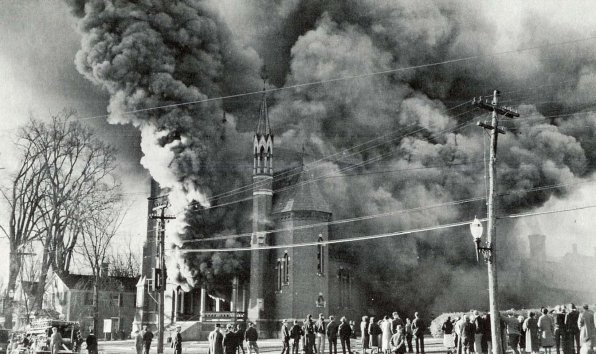Apparently some classic Concord photos are classic-er than others. The Insider office was buzzing mere hours after the paper hit the streets last week, with people phoning in their guesses about that week's photo, which was of a 1935 fire at First Congregational Church.
Truthfully they weren't guesses, though, as almost a half-dozen of the callers were at the scene that day, including Loretta Woodman, who was even visible in another photo of the fire re-run in a July 1979 issue of the Concord Monitor.
The flurry of responses fueled the desire for more research on our part, opening the door to a tale featuring the grippe, muskrats and doughnuts. Don't worry, we'll explain.
The fire took place just before 8 a.m. Nov. 3, drawing massive crowds to the street to watch billowing clouds of black smoke. Among those taking it in was Woodman, who lived in the area on Concord Street.
“I was there right after it started,” Woodman, who arrived at the scene with her husband, her husband's boss and his wife, said. “All the alarms were ringing and we were close by, so we were there right away.”
Jeanne Cate, a lifelong Concord resident, was only 6 years old, but recalls rushing to take a look herself. In fact, that tiny version of herself may be in the photo.
“My parents went right up to see it, so I'm probably in the crowd there watching it,” she said.
George Kidder, who lived in Concord for 47 years, was getting ready for Sunday school at the church when the fire broke out. He and his family could see the smoke funneling into the morning sky from their house.
“We lived up Washington Street about four houses above State Street, and you could look right down and see the smoke,” Kidder, who was 8 at the time, said. “My sister and I were already ready for church.”
Mary Pilsbury wasn't in Concord at the time, but her late husband, John, was. Pilsbury later moved to the city with John and currently attends the church, where they were still talking about the fire as recently as last week. Her husband also often talked about the fire.
“All of his family was brought up in that church, his grandfather and all of them. It was over four generations,” Pilsbury said.
The story landed on the front page of the Concord Daily Monitor the following morning, Nov. 4, and included a dramatic retelling, noting that several firefighters “escaped death” as the “hot air blast threw them to the ground.” Good to see reporters and editors using the same techniques to draw readers into a story almost 80 years ago. According to the article, the alarm had been sounded by two hunters – Donald Dustin and Floyd Dufresne – who were returning from East Concord where they were “seeking muskrats in the Merrimack River.”
Fire chief William T. Happny was said to have “left a sickbed to supervise the firefighting” after having been “confined to his home for three days with the grippe.” One fireman was “overcome” by smoke and was “taken from the basement in unconscious condition,” though he was revived 10 minutes later.
Other important facts noted in the story: The church organ was destroyed, which was something of a tragedy as it had been referred to reverently as “the finest tuned instrument in the city.” The grand piano used in the chapel, however, was saved and taken to Dr. Reed's home. (No mention of Dr. Reed's first name. Perhaps it was just doctor?)
More than one mile of hose was laid by firemen, and it was estimated that more than 1,000 onlookers appeared and more than 50 cameras were used, a staggering number considering that cameras and phones used to be separate items. And finally, in perhaps the most important development of the morning, “the ladies auxiliary to the fire department quickly arrived on the scene with generous helpings of coffee and doughnuts,” according to the article.









